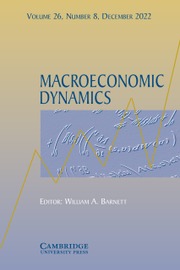No CrossRef data available.
Article contents
Climate investments, stock markets, and the open economy
Published online by Cambridge University Press: 20 November 2024
Abstract
We analyze the effect of green patents on G7 stock market returns. First, we build a small IS-LM model to identify the relevant channels, augmented with open-economy channels and the Green Tobin’s q (Faria et al., 2022). The model highlights that the intertemporal impacts of greening on stock returns are ambiguous. We then turn to an estimated global vector autoregressive model to more rigorously analyze the effect of monetary and green patenting shocks across the G7. Both shocks influence green patents through real and financial markets. As regards green patent shocks, results suggest that a tension exists over time between promoting pollution reduction and energy efficiency and the profitability of (green and brown) companies in the aggregate. We perform a variety of robustness exercises around our main results. Our results provide something of a challenge to the literature and call for more research effort to understand the various channels that might explain this dynamic—and in turn whether any particular policy recommendations follow.
Keywords
- Type
- Articles
- Information
- Copyright
- © The Author(s), 2024. Published by Cambridge University Press


